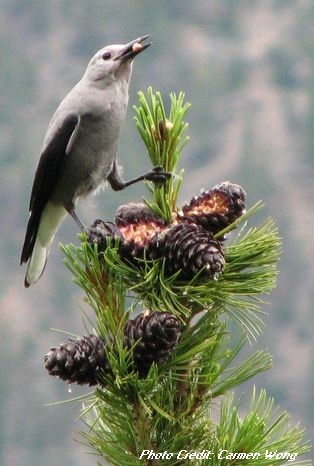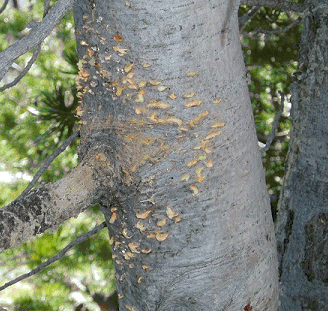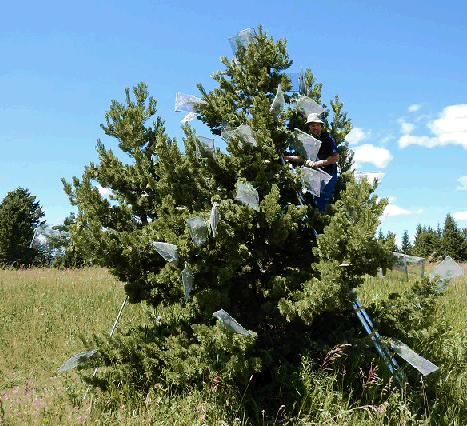| | What's so special about whitebark and limber pine?

Alberta has two endangered tree species: whitebark pine (Pinus albicaulis) and limber pine (Pinus flexilis). These species are endangered because they have been declining rapidly across their ranges. They grow slowly, only starting to produce cones around age 40 (limber pine) and 50 (whitebark pine). Reversing their decline is a long-term commitment. Without healthy populations of these keystone trees, their ecosystems would no longer provide the habitat and values that animals and people depend on, including slope stabilization; a rich source of food for birds, bears and small mammals; headwater streamflow control; subalpine tree island formation; and windswept scenic beauty.
Sustaining and conserving these trees means focusing on more than just the tree. Both of these tree species have evolved very heavy, large wingless seeds so they can’t be dispersed by wind. Whitebark and limber pine both depend on the Clark’s nutcracker, a bird in the jay family, to reproduce. After countless generations of co-evolution, whitebark pine cones don’t open when the seeds are ripe. The nutcracker pecks open the cones, extracts the large seeds that are high in protein and fat, and caches them in the ground with its beak. The nutcracker can store about 100 seeds at a time in a special throat pouch. Each nutcracker plants about 100,000 seeds and digs up about 30,000 each year from memorized locations as its main food. Survivors grow into seedlings. Limber pine cones open, but only seeds cached by nutcrackers germinate.
Threats to whitebark and limber pine

Four main threats affect these species. The key to recovery is to reverse or lessen the damage caused by these threats.
White pine blister rust
The threat
White pine blister rust (Cronartium ribicola) is a deadly human-introduced fungus from Asia that affects 5-needle pine trees and has spread through North America for over a century. The fungus needs both 5-needle pine trees (primary host) and currant bushes (alternate host) to complete its life cycle, although it does infect some other plants. Efforts to eradicate the rust by removing these alternate host plants have failed. It infects needles and grows into the main stem where it cuts off vital water and nutrients, killing the tree. When a large tree gets infected, it may take years to die, but when the crown starts to die cone production stops and its key ecological function is lost.
Recovery actions
Rare 5-needle pine trees have been found with natural tolerance or resistance to the disease. These trees must be tested to prove their resistance, a process that takes 7 years in a controlled facility, or longer in the field. Seeds from these special trees are collected and used for restoration.
Mountain pine beetle
The threat
Recent mountain pine beetle (Dendroctonus ponderosae) outbreaks have killed far more trees than in the past, and spread into higher elevation forests. Beetle populations have expanded outside its historic range due to recent fall, winter, and spring temperatures being too mild to kill overwintering larvae. Extensive mature pine forests allow the mountain pine beetle the opportunity to spread widely.
Recovery actions
Valuable blister rust resistant trees are protected from mountain pine beetle attack through the use of pheromones. These pheromones mimic a fully attacked trees’ chemical signals, which helps repel attacking beetles. Landscapes can also be managed to reduce the chance of beetle attack by changing the composition of species and age classes, and by removing trees already attacked by beetles.
Wildfire suppression and succession
The threat
Whitebark and limber pine trees have thin bark, making them vulnerable to fire, but they can also benefit from open habitat created by fire. Fire suppression promotes shade tolerant species like Engelmann spruce and subalpine fir, which form dense stands that hinder whitebark and limber pine growth.
Recovery actions
Identified rust resistant trees are protected from fire by Agriculture and Forestry’s Wildfire Management Branch. Some areas benefit from wildfires or prescribed fire through reducing fuel buildup and creating open caching sites for Clark’s nutcrackers.
Climate change
The threat
Whitebark pine and, to a lesser extent, limber pine, live at the environmental limits of tree growth. Warming is moving species higher in elevation and latitude – whitebark pine may be at risk of being forced off mountaintops as species shift upwards. Moving northwards is another option, but if suitable habitat is already occupied by other species, whitebark pine is a poor competitor. Conversely, climate models predict limber pine will benefit from more suitable habitat and favourable climates, especially in lower sites.
Recovery actions
Research is being done using climate models and testing assisted migration (planting populations and/or species outside of their current or historic ranges). These studies are providing information on management options for these species as their habitat changes, such as what seed sources may be most appropriate for restoration planting. Slow growth and centuries-long life spans show they have adapted and grown under a wide range of conditions.
 For more information on whitebark and limber pine in Alberta please follow the links below. For more information on whitebark and limber pine in Alberta please follow the links below.
|
|